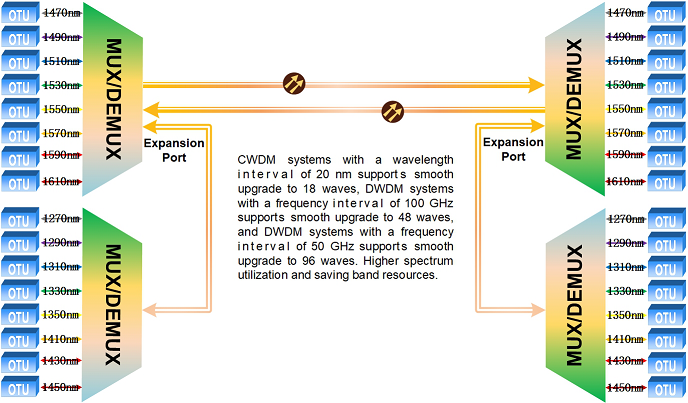
OADM/ODM
Product Overview
ODM Optical Add-Drop Multiplexer/Demultiplexer card is a CWDM/DWDM multiplexer introduced by Visint. It can combine and split CWDM or DWDM channels, greatly save customers' optical fiber resources, and flexibly change network configuration according to customers' needs. The frequency interval of 100 GHz DWDM system supports smooth upgrade to 48 waves, and the frequency interval of 50 GHz DWDM system supports smooth upgrade to 96 waves. Higher spectrum utilization, saving bandwidth resources. Moreover, the CWDM system supports a smooth upgrade to 18 waves.
Inquiry Now
ODM Optical Add-Drop Multiplexer/Demultiplexer card is a CWDM/DWDM multiplexer introduced by Visint®. It can combine and split CWDM or DWDM channels, greatly save customers' optical fiber resources, and flexibly change network configuration according to customers' needs. The frequency interval of 100 GHz DWDM system supports smooth upgrade to 48 waves, and the frequency interval of 50 GHz DWDM system supports smooth upgrade to 96 waves. Higher spectrum utilization, saving bandwidth resources. Moreover, the CWDM system supports a smooth upgrade to 18 waves.
Supporting up to 96 waves and can be customized
Pure passive without power supply, non-power supply debugging, transparent transmission.
Supporting online upgrade and expansion, simple maintenance and easy operation.
Supporting CWDM and DWDM (100GHZ or 50GHZ) applications.
Supporting multiple scene applications such as single fiber unidirectional, single fiber bidirectional, and dual fiber bidirectional.
Low insertion loss, high channel isolation, high reliability and stability, in line with GR-1221 standard.
Supporting SNMP-based unified network management platform, network management mode CLI, WEB, NetRiver (graphical interface).
Supporting local and remote control functions.
System Parameter | Technical Index | |
Wavelength range | CWDM: 1271nm~1611nm, DWDM: C-Band (100GHZ or 50GHZ). | |
Channel spacing | CWDM: 20nm, DWDM: 0.8nm/0.4nm. | |
Passband width | CWDM: ±6.5nm, DWDM: 0.1nm. | |
Passband flatness | <0.5dB. | |
Channel insertion loss | 4CH: <1.0dB, 6CH: <2.0dB, 8CH: <2.5dB, 12CH: <2.8dB, 16CH: <3.2dB, 40CH: <5.5dB, 48CH: <5.5dB, 80CH: <5.5dB, 96CH: <5.5dB. | |
Adjacent channel isolation | >28dB. | |
Non-adjacent channel isolation | >30dB. | |
Polarization dependent loss(PDL) | <0.1dB. | |
Polarization mode dispersion | <0.1ps. | |
Return loss | >45dB. | |
Maximum input optical power | >300mw. | |
Network management mode | CLI, NetRiver, WEB. | |
Product dimension | Single card: 177(W)*20(H)*225(D)(mm). Chassis unit: 482(W)*177(H)*250(D)(mm). | |
Environmental requirements | Working temperature | -10℃ ~ 70℃. |
Storage temperature | -40℃ ~ 80℃. | |
Relative humidity | 5%~95% no condensation. | |
Safety and EMC | Compliance with FCC, UL, CE, TUV, CSA standards. | |
Power consumption | <2W. | |
Visint® Vispace 1000 series optical multiplexing and demultiplexing equipment is widely used to solve the problem of insufficient optical cable resources in transmission. Fabricated by thin film filter (TFF) technology and planar lightwave circuit (PLC) technology, multiple optical carrier signals are multiplexed onto a single-core optical fiber for transparent transmission, supporting dual-fiber bidirectional, single-fiber bidirectional, single-fiber single unidirectional and other types.
Application 1: Dual-fiber Bidirectional
The dual-fiber bidirectional multiplexes multiple optical carrier signals onto the two-core optical fiber for transmission, thereby realizing the use of the two-core optical fiber to transmit multiple services, thus greatly reducing the investment cost and saving the cable laying time.

Figure 1: Multiplexing/Demultiplexing Dual-fiber Bidirectional Application
The single-fiber unidirectional uses the optical reversible characteristic to multiplex multiple optical carrier signals onto a single-core optical fiber for transmission, thereby realizing multi-channel transmission by using one-core optical fiber, thus greatly reducing investment cost and saving cable laying time.

Figure 2: Multiplexing/Demultiplexing Single-fiber Bidirectional Application
The smooth upgrade is to access the splitter through the expansion port of the splitter in the original WDM system to achieve smooth upgrade and expansion without affecting the original service.

Figure 3: Multiplexing/Demultiplexing Smooth Upgrade Application